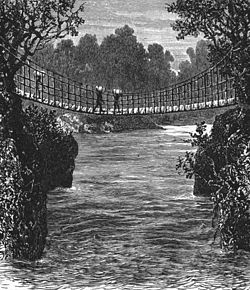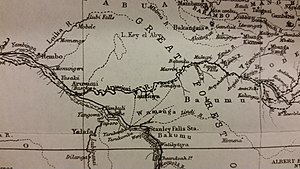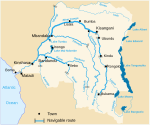Aruwimi River
(Redirected from
Aruwimi
)| Aruwimi River Ituri River Rivière Ituri | |
|---|---|
 | |
| Location | |
| Country | Democratic Republic of the Congo |
| Physical characteristics | |
| Source | Blue Mountains |
| • location | Lake Albert |
| • elevation | 1,182 m (3,878 ft) |
| Mouth | Congo River |
• location | Basoko |
• coordinates | 1°13′24″N 23°35′39″E / 1.223209°N 23.594298°E |
• elevation | 359 m (1,178 ft) |
| Length | 1,287 km (800 mi) |
| Basin size | 116,100 km2 (44,800 sq mi) |
| Discharge | |
| • location | Basoko, (near mouth) |
| • average | 2,200 m3/s (78,000 cu ft/s)[1] |
| Basin features | |
| River system | Congo River |
| Tributaries | |
| • left | Nepoko River |


The Aruwimi River (French: Rivière Aruwimi) is a tributary of the Congo River, located to the north and east of the Congo.[2]: Vol.Two, 214
The Aruwimi begins as the
Ituri Forest, becoming the Aruwimi where the Nepoko (or Nepoki) River joins it, at the town of Bomili. The river continues westward, joining the Congo at Basoko
. The length of the Aruwimi–Ituri-Nizi is about 1,287 km (800 mi), with the Ituri being about 650 kilometres (400 mi), the Nizi about 257 kilometres (160 mi) and the Aruwimi about 380 kilometres (240 mi). The Aruwimi is about 1.5 kilometres (0.93 mi) wide where it joins the Congo.
The watershed of the Ituri/Aruwimi is almost entirely dense forest, with just a handful of villages along its course, and crossed by roads in about four places. The
Pygmies
).
The Aruwimi was explored by Henry Morton Stanley during his 1887 expedition to "rescue" Emin Pasha. The cataracts above Yambuya made it impossible to use the river for navigation, and the expedition had to go by land, with tremendous difficulty.
Tributaries:
Settlements:
References
- ^ Alberto, V. Borges (2019). "Variations in dissolved greenhouse gases (CO2, CH4, N2O) in the Congo River network overwhelmingly driven by fluvial-wetland connectivity".
- ISBN 0486256685
- ISBN 978-92-5-102983-1.


